Running time 1 hour and 19 minutes of Dali time, rated at 4.0/10 from 31,671 time wasters.
Conceived, written, directed, produced, and loved by Ed Wood, Jr. Because it is excruciatingly bad, it has attracted a following as witnessed by the extraordinary number of votes on the IMDb. This for a movie without a theatrical release.
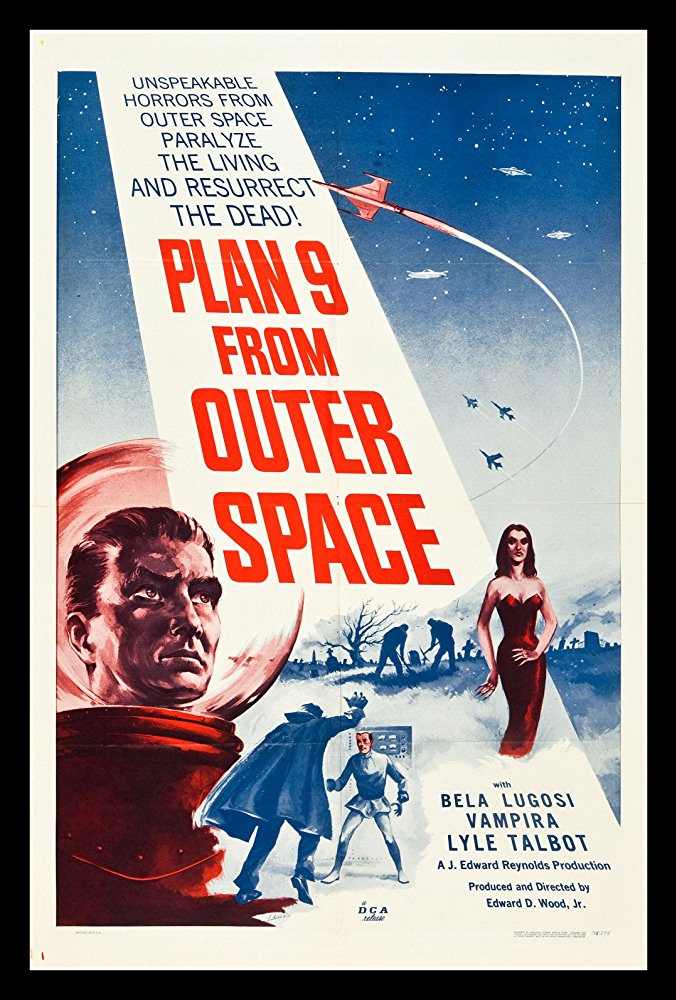 DVD cover.
DVD cover.
Leaving that reputation aside for the moment, here is the set-up. The aliens have tried eight times to communicate with Earthlings. Each attempt has failed. Even when contact is established Earthings simply deny the reality of flying saucers and aliens despite the evidence in front of their eyes. Hmm. That has a contemporary ring. Climate change deniers, anti-vaxxers, Tony Abbotts, unite!
Using non-Aristotelean logic, the aliens give up on living humans and decide to raise the dead (using John 11:38-44 as a manual) and work with them! Work with them? Yes, to destroy the Earth! Egads, why? Because Earthlings are violent, destructive, hostile, and aggressive.
The aliens declare that the Earthlings will not be satisfied with blowing each other up but as technology develops they will start blowing up other worlds. Does that sound like GOP foreign policy? I could not possibly say. That aliens have come to stop Earthlings from destroying the Earth, the solar system, the galaxy, or the universe is a theme in Sy Fy. Wonder why?
Since Earthlings will not negotiate, it is time for the final solution: Plan 9. Vampires provide the creatures for this feature in the dark and misty graveyard where much of the film is set. Though some scenes switch, inexplicably, between day and night and back. Is this post-modernism at work, refusing to privilege continuity!
The flying saucer makes little effort to conceal itself relying for concealment on the delusions that explain the Republican Party today.
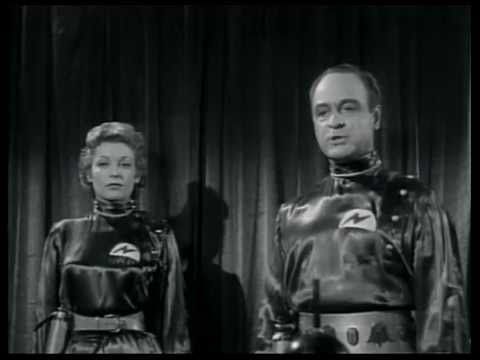 First they iron the shirts and then shine them.
First they iron the shirts and then shine them.
These technologically superior aliens in shiny sateen rigs are defeated by a couple of muscle men who are violent, destructive, hostile, and aggressive, in other words, typical Earthlings. That’ll show ‘em to call us names!
But it ends on a note of caution that they, the aliens, will be back and we have to be ready for them. What does that mean, ready? When they say Earthlings know nothing but violence, just blast them. That works. We’re already NRA-ready!
The production is amateurish. The cardboard walls shake when someone touches them. The flying saucer is sometimes called a cigar (and later it is lit) but it is always shown as what it was, a spinning top. The acting is painful to watch as the players struggle to remember their lines and deliver then slowly with no inflection. The sets are empty, e.g., the cockpit of the passenger aircraft shown twice is two folding chairs, confirming some perceptions of American Airlines.
There are voiceovers that are mawkish and confusing. It is introduced and concluded by a reincarnation of Charles Fort, the favourite author of the fraternity brothers.
Of the cast only Gregory Walcott seems to have had a film career, mostly in television, especially westerns when they were the fashion.
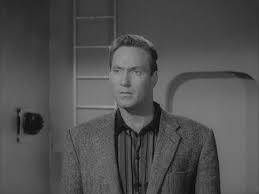 Gregory Walcott
Gregory Walcott
Perhaps his North Carolina accent made producers think he was from the west. West, south, there is no difference when viewed from Hollywood.
The gossip on the web is that Ed Wood started this project as a biography of Bela Lugosi, who figures in about two minutes of the film, and then Lugosi died. Had he seen the rushes? Nothing stopped Ed Wood. He hired his wife’s doctor to stand-in for Lugosi hiding behind the cloak held to his face.
 Is there a doctor in the cape? Yes.
Is there a doctor in the cape? Yes.
That the good doctor was a foot taller than Lugosi with a different colour of hair was ignored. For all of this and more see ‘Ed Wood’ (1994), a biopic
Category: Film Review
‘The Killings at Outpost Zeta’ (1980)
It runs 1 hour and 32 minutes of Dali time, scored 4.4/10 from 212 friends and relatives of the producer on the IMDB.
Outpost Zeta is a crucial toehold in a vital part of the galaxy. OK. The original garrison went off the air. A rescue mission went in, and it, too, went silent. Then a second. Still nothing. Gulp! Whatever is going on at Zeta, it is not good.
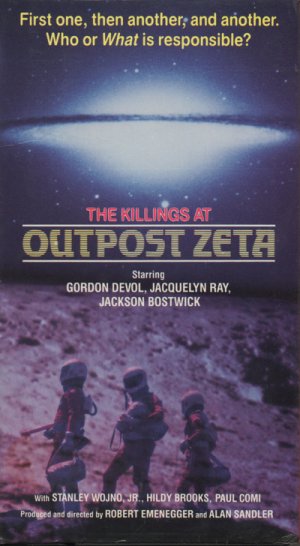 DVD cover.
DVD cover.
A third rescue team of volunteers is assembled, who then dutifully make last wills and testaments. That is a sobering beginning to this low budget creature feature. They are five in number or is it six. They are slain one by one. No wonder, to defend themselves from the unknown and unseen menace they have caulking guns! Still less do they wear any body armour or space suits. The tip jar did not run to such accoutrements but the local hardware store had caulking guns on special.
When arriving at Zeta, they find a space buoy with a message from one of the benighted rescue teams warning them off. Needless to say, this warning is disregarded and they land.
Mercifully we get no backstory for these volunteers. One pales to think what this screen writer would have done with that. Mawkish, adolescent, trite, these are the words the come to mind. Yet none of them strikes this viewer as the volunteering type, pursed lips or not. They are too young to be fatalistic. They are so unlined and unwrinkled, do they have the experience and cool heads to survive where others have, evidently, not.
The squeamish medical doctor is a woman and there is not one demeaning, derogatory, or sexist remark from the Sensitive New Age Soon-to-be-Dead Men. There is also a woman scientist who squawks about the hindrance of security. Yes, one would belittle security after eighteen mysterious deaths. Sure. She is the first to go, and ‘Good riddance!’ shouted the fraternity brothers.
The team does show interest in this strange and alien world. This fact is worth noting because in many B Sy Fy entries the explorers of new worlds show no interest in the new world. These six do. There are a couple of other things to like mentioned below.
The acting is pursed lips, furrowed brows, open-mouthed stares, and many blank looks. The directing is leaden. The production values are homemade. We get a few creature’s eye view that lets the air out of the mystery too early. There is also much heavy breathing. Much.
But the surface of Zeta is eerie and forbidding with an orange filter on the lens and I got to like their red jumps suits and visored white crash helmets. I liked the landscape because it did look strange, unlike so many of these Z movies where the alien world is the producer’s backyard, and looks it. I liked the visored helmets because they were used, not opened for close-ups. It put distance between the viewer and the players with some verisimilitude. Contrast this latter point to ‘Arrival’ (2016) where the safety mask is removed almost immediately for close-ups thereafter. Such is the ego of actors.
 The fashion on Zeta
The fashion on Zeta
Moreover, I liked the creature, some moving hot rocks. Why like murderous hot rocks? Because they are the descendants, surely, of the Horta from ‘The Devil in the Dark’ of Star Trek the Original Series in series one in 1967.

This film, however, lacks the mystery and the compassion of the Star Trek episode. It is played strictly as a hot-rock-creature feature, not an existential rumination on sentience, consciousness, communication, and compassion.
No surprise to see that none of those associated with this film have substantial CVs on the IMDb.
‘Creature with the Atomic Brain’ (1955)
One hour and 9 minutes of running time, scored 5.5/10 from 842 votes.
More a creature feature than Sy Fy, but from a story and screenplay by that Sy Fy journeyman Curt Siodmak and starring the future governor of Hawaii, Richard Denning(er). The director was Edward Cahn.
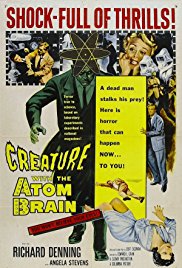
It has a grim opening with a figure walking, dead-eyed, down a darkened, tree-bowered residential street.
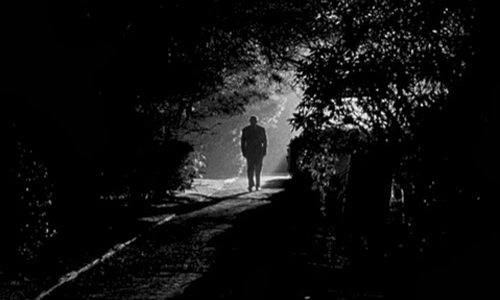
Nice. It gets off to a good start.
A gangster is murdered, then the DA, each time the murderer leaves behind finger prints galore. In case plod misses them, they glow in the dark! The police swing into action, aided by the Governor. Wait! The finger prints trace back in each case to a dead man!
Yes, there is mad scientist with plenty of Bunsen burners at work, implanting electrodes into the brains of recently dead men. Being a sexist he does not body snatch dead woman and give them equal employment opportunity as criminal zombies. He powers the electrodes with radium, hence the word ‘atomic’ in the title, but the creatures are multiple not singular. Since the scientist speaks with a German accent, IMDB reviewers assume he is a Nazi, but there is nothing in the film to support that interpretation apart from the accent. In fact, the actor is Gregory Gaye who was born in Russia and he faked the accent.
His research into brains, electrodes, radium, and espresso has been funded by Frank, a notorious villain who is out to wreak vengeance on criminal business rivals and lawmen. He is as merciless as Ming. In fact, the mad scientists wants to quit but… well, research grant KPIs are KPIs
We do not get to see the body snatching but do get a look at the lead-lined laboratory, lit by Bunsen burners, Bad Frank and Mad Scientist have to crawl through some (unexplained) plastic wrap. It was an unusual effect, but there no point to it, i.e., unless in 1955 plastic shields radium. They crawl through it once and we see it four times. In case we missed it the first three times.
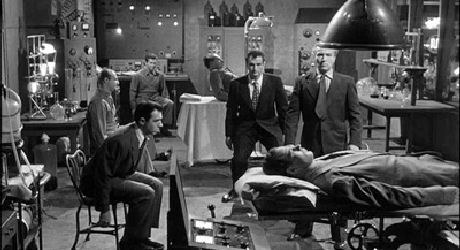 Inventory of the dead.
Inventory of the dead.
Denning goes around thinking, rather than kicking in doors, and is pleasant and polite, so different from current Hollywood Hop-Heads who yell, stomp, and sulk. He enjoys a normal home life with homemaker wife.
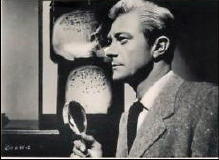 Denning thinking.
Denning thinking.
She is the Donna Reed stereotype of the time and place but perhaps it is more honest than those Sy Fy films of the period that include a lady scientist and then thereafter belittle her and limit her actions to serving coffee and treat her as an object fo the men to fight over.
There is also pathos when one of the avuncular police officers is murdered, and who yet in death helps to undo Big Bad Frank.
Speaking of the stereotypes of the time and place. The army and police are presented as responsive, competent, diligent, dutiful… Well, it is a work of fiction. Where are the lazy coffee drinkers, the petty martinets who will not move without a written presidential order, the oh-hummers who are bored by the end of the world, the corporate underminers? No, the forces of order are not always presented in that way in creature features of the time. In ‘Not of This Earth’ (1957) the local police are lazy, incompetent, heedless, and unresponsive. That seemed more likely to this jaded viewer.
Many zombie movies, and this is the sub-class for this one, made during the Cold War were thinly disguised references to communism. It is easy to see how that can work. Yet in this case I did not get that impression. There is no greater purpose in the film than a few twists and turns to entertain an audience.
Cahn turned out B features ten or more a year with titles like ‘It! Terror from Beyond Space’ (1958), ‘Zombies of Mora Tau’ (1957). ‘The She-Creature’ (1956), ‘Voodoo Woman’ (1957), ‘Dragstrip Girl’ (1957), ‘Invasion of the Saucer Men’ (1957), ‘Cures of the Faceless Man’ (1958), ‘Invisible Invaders’ (1959), and more. What a CV.
‘Target Earth’ (1954)
The facts from IMDB: 1 hour 15 minutes, 5.7/10 from 814.
The Russians are coming! But some citizens have slept through it. What an advertisement for Serta.
Backup. This is one of those Empty City/Earth movies. Where have all the (other) people gone? A few scattered individuals emerge to find…silence, more silence, and each other.
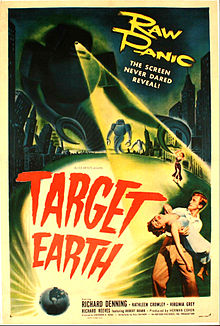
First they have to accept the situation: They are alone. Next they have to decide what happened? Where is everyone else? Third, what shall we do?
Tensions arise at every step.
One of the tropes is leadership. Will a leader emerge from this random assortment of individuals? If so, will there be rebellion. This premiss provides rich pickings for a screen writer.
It all goes pretty much according to formula, but if formulaic it is nonetheless creative. The opening scenes of the quiet cityscape at street level are arresting. The inserts of stock footage reinforces the abandoned look of this large city. (Chicago in the original story, but filmed in Lost Angeles. On that more later.) The beginning is very eerie and promises much.
The camera cuts to a Kathleen Crowley gradually awakening. There is no sound. None. She does not moan or groan. There is no street noise, yet it is hot, there is sheen of sweat on her, and the window is open to a slight breeze on the curtains. Silence. She fumbles around and gets dressed. We hear snaps, clicks, and snicks as she dresses, opens, and closes drawers and doors but nothing else. On the way out of the apartment building she knocks on a couple of doors to no reply. She meets no one but she seems inwardly preoccupied, as though late for a 360-degree review with a McKinsey-speaker. We notice the empty silence but she does not, quite. She hurries along the empty street and gradually realises this is not right. She comes across a dead woman lying on the street. ‘Gasp’ is the first sound. Definitely not right!
This silent opening was daring indeed, and given the attention-span deprived audiences today, no film maker would dare do it now. Everyone would reach for the iPhones in boredom to check-in on Facebook. Yet it offers mystery, tension, eerieness, the more so because the audience realises the silence before Crowley does.
Now she hurries on, we know not where, and the silence remains, until…. she turns a corner and runs into Richard Denning. Say his name with respect because he did not survive ‘The Creature from the Black Lagoon.’ Later Denning was the 5-O governor of Hawaii with an office in Iolani Palace. Some CV, gobbled up by the Creature from the Black Lagoon, but making a come back as governor, and in that palace.
She is fearful and Gov slaps here around to tell her he will not hurt her! This is 1950s man-logic. Smack! See, I won’t hurt you! Smack! (Remember Denning did not write it that way and enjoyed a reputation as a gentleman professional.) After she has been beaten into submission, they club together and head for mid-town on the assumption there will information, if not people, there. Along the way they establish that the telephones are out, and no one has a iPhone. There is no electricity for radios.
Then in silence they hear sounds and trace them to a bar where a couple are carousing, devil may care. Virginia Grey and Richard Reeves are the players both instantly recognised from countless supporting roles, but here getting a lot of camera time. She has chiseled cheek bones and he is a man-mountain. Now the team is four and clearly Governor Richard is in charge. Off they go, and find automobiles have been purposely disabled. By this time Gov has concluded that there have been an evacuation.
Having just got in from Detroit, travelling eighteen hours, he slept through it. Crowly was comatose from an OD of sleeping pills. Grey and Reeves were sleeping off an alcoholic stupor before starting the next one.
It must be W A R. Yet there is no rain of bombs or missiles, just empty streets. They find another corpse.
Then there appears another citizen, frazzled, clothing askew, like he just came from a frat party, who says he has run away from the invaders on the North (Korea) Side of town, where there is indeed destruction. He is hysterical, a duty usually consigned to a woman. Nice change.
While the characterisations have been changed from the original story the narrative so far is consistent with it.
Now it diverges. For while the five gabble, a shadow falls on a building. A giant shadow. They take cover. The shadow wobbles. Is this the Amazing Colossal Man on the loose again! or The Fifty Woman who got rid of Abbot and Costello (I wish). Mr Hysterical runs amok into the street and the Shadow, a tin man, zaps him with a Gort eye-ray. Poof! That is some hysteria cure! Oh oh.
They hide in a hotel on the assumption ‘they’ will not search all the rooms just yet, because this is an advance patrol moving in from the North. Bloody Canadians! The weather has finally driven them south, and this big thing, must be an armoured polar bear. What other explanation could there be, Erich? Although how this giant will enter and search a hotel is a question best left unasked.
The deviation from the story is showing the Big Tin Man. In the story the invaders are unseen. Given how clumsy and awkward Tin is, that might have been better. Tin is slightly more agile than Chani from ‘The Devil Girl from Mars’ who tripped over his own size twenty-two shoes. This robot is stunt man Jack Calvert who make robots a speciality. This outing must have been early on that career path before he perfected a technique.
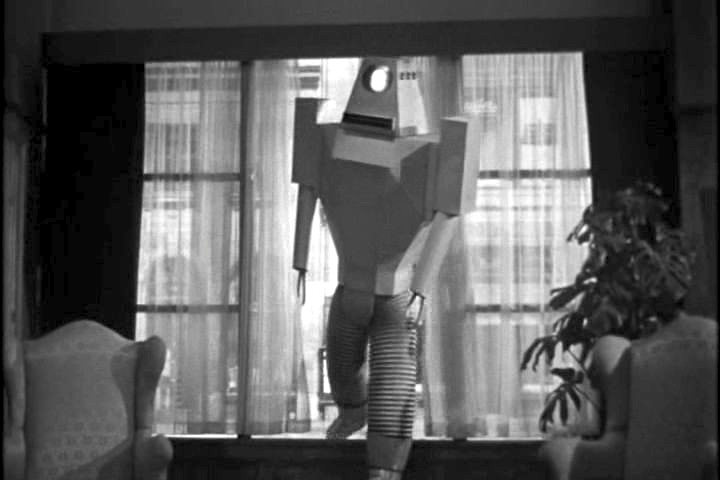 Enter Tin Tin
Enter Tin Tin
The second deviation is that about now we get cross cuts to a military operations room with lots of extras in mismatched uniforms from an Army Navy Store. They know nothing except that something has happened. Well that confirms the street cred. Solution? Bomb it!
Much stock footage of war planes taking off, retracting landing gear, assembling in formation, flying off in great numbers. They fly over the city observed by our team, and then they are blasted out of the sky in a sun burst. Not very well done but we got the idea. Kaboom! No more airplanes. That eye-ray is a killer.
The colonel at HQ is flummoxed. ‘Bomb’ was the only play in his playbook. By the way would a chicken colonel be in charge of bombing Chicago, Lost Angeles maybe, but ChiTown? As per usual there is no indication that there has been any effort to communicate or negotiate with the invaders, say, by offering them Mexico, Russ Limbaugh, or Paris Hilton.
Despite radar, telephones, underlings, fruit salad, and pips, the colonel knows nothing about the invaders. On the street, we know they are tin men. Well there is only one Tin Man, but that is enough with that eye death-ray. (In high school there was a rumour that Mrs Picks who taught Latin had a death-ray called the ablative case. No one every dared test the myth. Or if they did, poof, there was no report.)
The happy campers four do not offer the screen writer enough tension so he added a psychopathic killer to the mix. He has a gun, of course, and is addled. He is also a relative of the moneybags who invested in this celluloid, and so he is a must. His inexplicable behaviour leads to the final confrontation with Tin, and it is a good thing they found can opener in time.
The invaders are technologically superior because they got there, though Canada is not that far away, are brought low by merciless Yankee ingenuity, whereby they play Bing Cosby singing ‘White Christmas’ repeatedly and this cracks the robots eye, and the cyclopes go down, down, down. Who would not? Hard as it is to believe, bombing is not enough. By the way, the ever reliable Whit Bissell came up with sound effect. Well done, Whit.
The survivors begin stockpiling more Der Bingle records because THEY will be back. These inhuman invaders were Russians in tin cans, right? Only team work and w(h)it can defeat them. Oh, and Der Bingle.
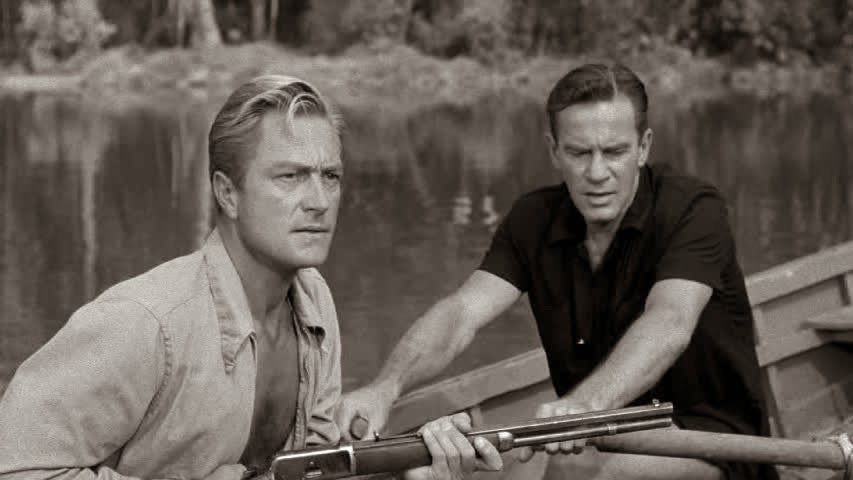 Richards Denning and Carlson hunt the Creature from the Black Lagoon.
Richards Denning and Carlson hunt the Creature from the Black Lagoon.
Denning did an MBA and went into business which he found a bore and he dabbled in amateur theatrics where he was encouraged to enter a radio contest, which he did and won. The sponsor of the contest gave him a screen test but rejected him because he looked too much like an actor already under contract. But by now Denning wanted to escape spreadsheets and pitched himself to Paramount and was born his B-movie career, for despite his good looks, easy manner, and professionalism he never ascended the heights, but he always had work and retired early to Maui, showing his good sense.
He was lured out of retirement for 5-O on condition that (1) he never had to leave Hawaii and (2) that he would not be required for every episode. That was agreed. (The rumour is that when Jack ‘Look at that Hair’ Lord quit 5-O he chose to stay on Maui, too. In our visits to Maul we have been unable to confirm this story. The search goes on.) Knowing Denning’s commitment to Hawaii caused his star to rise further in my cosmology.
The cynics think that the advertising department demanded that the Tin one be inserted into the movie to appeal to the creature feature market. Tin certainly does not add to the action, since he is largely immobile. Nor is the death ray all that exciting. More like a blurred screen that a mighty, crackling zap. Maybe he needed lessons from Gort.
The empty city is in fact Lost Angeles. This tip jar budget did not run to securing a police license with accompanying fee to film on the city streets, so it was done on the QT with a skeleton crew in a van going here and there in the very early morning. The film was then edited to remove any environmental sound and cut out passers-by. It is well done and the more intriguing for knowing how it was done.
‘The Bamboo Saucer’ (1968)
1 hour and 43 minutes, 5.6/10 from 274 ballots.
A throwback from the 1950s. Word on the internet street is that it was made in 1966 and shelved. That part is easy to see why. Yet it could not have been made during the coldest part of the Cold War for reasons made clear below.
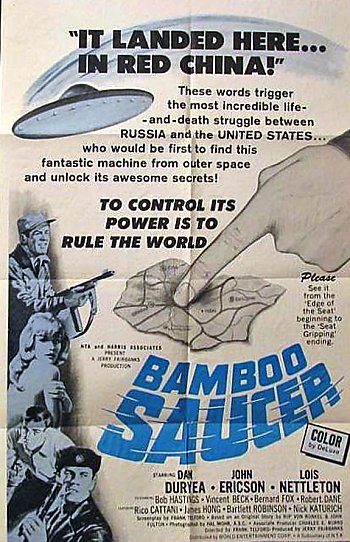
Here’s the deal. Eric the Fly Boy reports seeing a cobalt blue flying saucer during an X-plane test flight. Oh oh. That gets him grounded as a nutcase. We saw it, too, and know Eric is solid.
He becomes obsessed with vindication. Then he gets called to D.C. where he meets Dan who considers Eric an expert on flying saucers. DC Dan is a big wheel and telephones with demands hither and thither to throw his weight around. Fly Boy Eric is impressed and signs on.
Signs on to what? Well he did forget to ask, but DC Dan tells him anyway. There is a flying saucer sitting in Red China and we are going to get it before Mao realises it is there and gets his chopsticks on the iPhone within. Mao doesn’t know? No, it is in a remote part of China. We are later shown this with matte paintings of the Alabama Hills outside LA. Mountains equals remote. Got it.
Plus the saucer landed itself in a dilapidated, roofless Catholic Church, whether apse or naive is not specified. Since godless Commies do not go near churches the local authorities have not noticed it. The local peasants saw it land and saw two human figures emerge but keel over, die, and decay into dust. (Too long without coffee! What other explanation could there be, Erich?) The locals have passed the intel onto DC Dan because the peasants are oppressed by the regime and are plugged into the USA spy network even out there in the mountainous sticks. Got it.
DC Dan was 65 in 1968 and it is painful to watch him bail out of an airplane over remote China in the night, carry an empty back pack, and climb over papier-mâché boulders. When the action starts he moves like molasses. Sorry, Dan, but it is true.
DC Dan, Eric Fly Boy, and two tubby technicians are this A-Team. No sooner are they wandering about the Chinese Alabama Hills then they run into a Russian A-Team. There is much bluster and many threats but the script is clear, both teams are on the same mission, and neither wants to cross chopsticks with the Chinese. Anyway the Chinese are busy oppressing peasants. Got it.
This is the part that could not have been done in 1958. The American and Russians join forces to find the saucer, to fathom the saucer, and to evade the Chinese. No doubt each side will break the alliance when it is ready to do so. It sounds better than it played.
Another feature that would not have been done in 1958 is that DC Dan and the Big Russian are pretty much alike and DC Dan acknowledges this. The Enemy of Freedom and the Defender of Freedom are both bastards. Huh? No wonder it had no market for its message.
Lois Nettleton is a scientist with the Russians, and she gives Fly Boy a lecture on the equality of women in the workers’ paradise before the Big Russian slaps her down for not putting enough sugar in his tea.
DC Dan and his Russian alter ego are consumed by the mission, so Lois and Fly Boy pair off in the bushes. The other scientists reminiscence about pi derivations.
They elude routine Chinese army patrols. Due to budget cuts these conscripts have no eye glasses and don’t see much.
The Russo-Americo team finds the saucer. First problem is to get in. Much scratching and pounding. Meanwhile one of the scientist gets out his portable electric razor to tidy up, as you do on your first secret mission behind enemy lines, and ‘Voila!’ The saucer opens up to the gentle buzz. Being clean shaven got him into the saucer, if nothing else. Once in they have to fathom the gizmo.
Fly Boy grabs levers while the scientists deploy the slide rules they carried on the parachute drop.
The Chinese arrive in force and a shot-out results, but the near sighted Chinese cannot hit anything. DC Dan and the Big Russian stand back-to-back and blast about a hundred extras until the pile of Chinese bodies falls on them. Squash.
The time for slide rules ends. Fly Boy grabs another lever and off they go. Whoosh. They wobble around the Solar System for a while, until they encounter the de rigueur meteor, allowing Lois to scream. The fraternity brothers hoped it would end there, leaving us to wonder about the in-flight service, frequent saucer points, and toilet facilitates for humans. But no, there is a pompous coda.
Fly Boy and Lois clinch to affirm Americo-Russo friendship. They get control of the saucer and go back to Earth to land in Geneva of the Swiss where they will give the saucer to the world, which will lead to world peace. Why? Because those Saucerites will be back and we have to be united. Why? Maybe they came in peace looking for Klaatu. Are the Chinese invited?
The production is soap opera quality with many pauses as each actor reacts to a remark. The scenes related to the test flight are film school. Ditto Fly Boy’s sulking around afterward. The acting may not improve but there are fewer close-ups to remind the viewer later.
Video quality was excellent. After some Sy Fy movies seen lately, the saucer effects were neat.
This was DC Dan’s last film and he died before it was (finally) released. This Cornell graduate went into advertising and that brought him into contact with actors and on a bet he auditioned and got a part in a theatrical production. That was fun, and he did another. When a Broadway play he was in was to be filmed, he got the film part and went West, where he stayed. There seem to be hundreds of credits on the IMDb and he did everything. Some romantic leads in the 1940s, supporting actor, and sometimes villains in film and television, westerns, noirs, dramas, and even comedy.
A Double Creature Feature.
First, the undercard ‘Space Master X-7’ (1958), running 1 hour and 11 minutes, rated at 5.3 from 298 preferences.
 A lobby card that misleads audiences. Typical.
A lobby card that misleads audiences. Typical.
The Sy Fy aspects are few and quickly pass from the story. A rocket called, modestly, Space Master X-7’ returns its cargo of samples (from parts unspecified to my memory), which when spread around kill people. Morale. Do not spread space samples around. Ever wonder what that Moon rock in the National Cathedral in Washington D.C. is up to?
The sample becomes an enveloping and mortal fungus with the personality of a GOP senator. It destroys all without a backward glance. See, the comparison is apt. This fungus might have been a metaphor for Communism in a 1958 pix, made during the Cold War, but I did not detect any such innuendo. No, the sledge hammer script went at it literally, a fungus is a mushroom beyond the plate.
At a top security base in the remote desert Southwest a scientist, about whom more later, examines the sample, after much stock footage of rockets, parachutes, tin cans, and security blankets, uh, boxes. But people keep interrupting him, so he takes the sample home to work uninterrupted on it there.
Top security, right.
While poking the sample at home he has an argument with his ex-wife come a-calling. She goes away in anger and he keeps poking. Whoops. The fungus has had enough of that and it is goodbye scientist. Gulp. In truth, and very risqué for 1958, though the she and he had a child, they were, in fact, not man and wife. Gasp! In the morēs of the time that transgression allows a fate to befall the poking scientist.
By this time the slow-witted security officer at the base, played by Bill Williams, with his usual concussed look, comes to the house and seeing the fungus has had its way burns the house down. To avert a panic he puts about the story that the scientist died in the fire, and that they are looking for the woman seen there. In turn she thinks they suspect her of the fatal arson and takes evasive action. Bill wants to find her to stop the spread of the fungus but she knows nothing of this fungus, having not entered the home lab. This part is believable: she outwits the FBI, the USAF, and the police for an hour.
Per B-movie conventions they track down this interplanetary Typhoid Mary and that is that. The origins of the fungus, how to avoid it in the future, and such details are ignored.
Hardly Sy Fy.
There are only two interesting things about this overrated dross. Two of players are immediately recognisable. One is the scientist who is played by Paul Frees and many viewers, young or old, would twitch. He was a voice actor who did that work for two or more generations, much of it in animated movies until 1987 with ‘The Wind in the Willow.’ He also does the announcements at the train station in this picture, after the scientist is dead. He calls the timetable from the incinerator.
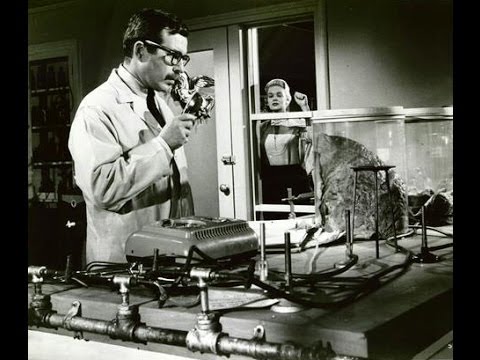 Frees in lab coat.
Frees in lab coat.
However, I remember that voice well from ‘The Milllionaire’ (1955-1960) where each week the heard but unseen John Beresford Tipton voiced by Frees handed over the dosh.
His Sy Fy credits as a voice actor are many and include ‘When Worlds Collide’ (1951), ‘The Thing’ (1951), ’War of the Worlds’ (1953), ‘Space Attack’ (1955), ‘Earth versus the Flying Saucers’ (1956), ‘The Twenty-Seventh Day’ (1957), ‘The Mysterians’ (1957), and ‘The Time Machine’ (1960). Like other voice actors his name seldom appeared in the credits but he always had work, unlike many credited actors.
The other notable player is Shemp Howard of The Three Execrables playing a straight part as a cab driver. Seeing him, the fraternity brothers waited eagerly for the pie in the face and were disappointed.
Now for the main event. the very superior ‘This Island Earth’ (1955), running 1 hour and 26 minutes with a 5.9/10 from 7413 opinionators on the IMDB.

It stars Rex Reason’s chin as the Earth’s greatest scientist and test pilot. While flying his X-Plane it conks out, ever the peril with the low-bidder products, and a green aura surrounds the aircraft as it gently descends to Earth.
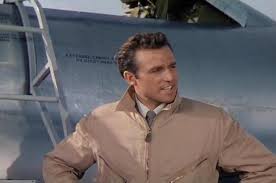 Chin and airplane.
Chin and airplane.
While Rex is used to the unusual in his charmed life this experience does give him brief pause. But only that. He goes to his top secret laboratory where strangers come and go at will. Next thing you know boxes and boxes of equipment arrive unordered, and with Allen Key in hand Rex and his obsequious assistant start putting together the Ikea television it becomes.
Once complete Siri turns herself on (down, fraternity brothers!). and there is Jeff Morrow with the strangest haircut congratulating Rex’s chin on winning the Nigerian Research Grant Lottery, first prize is an all-expenses paid trip to a secret locale where there is another laboratory. Who could rest that? Not that chin.
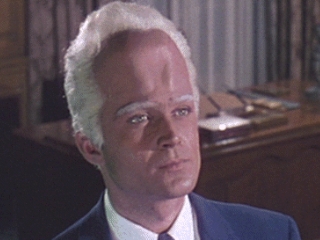 Check it out, and there are more like that at home!
Check it out, and there are more like that at home!
Spoiler coming.
Jeff and that white bouffant are from MetaLuna, well that is what it sounded like to me, which is losing a war because it is running low on nuclear energy. Being vastly superior beings they have sent Jeff via a nicely realised flying saucer to gather up scientists from all over the galaxy, though none of these other gatherees do we see, to synthesise nuclear energy on MetaLuna. Yeah, sure. Just add radium.
Jeff provided the green aura that saved Rex and his chin.
Among the scientist Jeff has gathered in his castle in the desert hideaway is Faith Dominguez. ‘Nice going, Jeff,’ shouted the fraternity brothers. While last year she and Rex did some skinny dipping when at a conference in Vermont (are there conferences in those woods?) she feigns not to recognise that chin. Since that is impossible he knows something is amiss but keeps it to himself.
The Professor from Gilligan’s Island is there, perhaps this explains how he got tenure on the islet, and with Faith he tells Rex that Jeff is not to be believed or trusted. Disbelief and distrust are now the order of the day.
While Jeff is Mr Congeniality, he has a mini-me with the same hair who is a white lab rat. Jeff reports to The Hall Monitor on an OLED Smart television and stalls for time while the scientists work, but the mini-me later tells The Hall Monitor that Jeff has gone native, watches baseball games, eyes off Faith, plays Monopoly, listens to Mozart, and has generally gone native and it not to be believed or trusted. Disbelief and distrust are now the order of the day.
This is the toxic atmosphere typical of most organisations, so Rex gets on with caring for his chin. When he cannot find a razor, he decides to escape with Faith and since the Professor seems an ever-present third wheel, him, too. Meanwhile, The Hall Monitor overrules Jeff and demands that he pack his scientists on the flying saucer and return home where they will keep working in a slave laboratory. Mini-me pursues Rex and company with lightening bolts. Zap! The Professor sacrifices himself for the man with the better chin, and a passerby is also zapped to show what lousy aim mini-me has. No wonder these superior beings are losing the war with gunners like that.
When Rex and Faith are flying away in a conveniently parked Piper Cub, they are John Deere tractor-beamed on board the flying saucer and whoosh…..
Jeff tells his sad tale as above. More whoosh.
Security may be a joke to the USAF but TSA full body scans are necessary to land on MetaLuna.
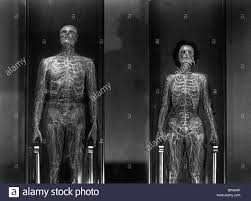
On MetaLuna the war is lost and Jeff defies high command and steals the saucer, evidently the only one left, to take Rex and Faith back to Earth. He does; he dies. They descend in the Piper Cub. Chin and Faith cuddle up in the Piper Cub, which hardly seems possible, with no further thought to the Meta-heads.
Meanwhile, the fatally wounded Jeff nobly crashes his saucer into the sea to be found later in other Sy Fy films.
The saucer effects are good, and the flight over the battle scared MetaLuna is effective, as is the shattered underground fortress, though the insect peons are there only for the creature feature advertising. Faith screams on cue. The pace is good. The sets are well designed and there are plenty of extras with that hair. It has the look of a A-picture. While Faith has Sy Fy credentials, the Chin does not, while Jeff has at least one other on his cv.
The gossip is that the original script played Jeff as a villain but the actor Jeff Morrow, who was well-known as opinionated, argued with the director, writer, producer, and busboy to make Jeff more human and rounded. He won and he was. This Jeff is a decent alien driven to extremes by circumstances beyond his control. He has indeed gone native, and was probably watching ‘I Love Lucy’ instead of beating the scientists into success with a slide-rule.
OK, but that does not explain the hair. Still less does it explain the fact that every other Meta-head we see on MetaLuna has the same hair under a clear plastic football helmet, except the Hall Monitor whose exalted status, apparently, frees his locks. Efforts to find a picture on Google Images failed. Suppressed!
The Hall Monitor has some pretty unkind remarks to make about Earth and Earthlings. He is a graduate of Kim Jong-un School of Intergalactic Diplomacy.
Faith Dominguez is there to scream and scream she does. She is not even permitted a lab coat! What a travesty of science.
Nor did I figure out any meaning from the title, on this the Nth viewing. I did not get any Cold War vibe from it.
‘War of the Satellites’ (1958)
IMDB rates if 5.1/10 from 441 casters. It runs 1 hour and 6 minutes.
Sputnik went beep-beep in October 1957 and overnight space flight became main stream, no longer for kids in ‘Space Patrol,’ ‘Rocky Rocket’, or ‘Flash Gordon.’ Independent film producer Roger Corman rushed to turn out the first post-Sputnik film in a deal with Allied Artists. This is the result.
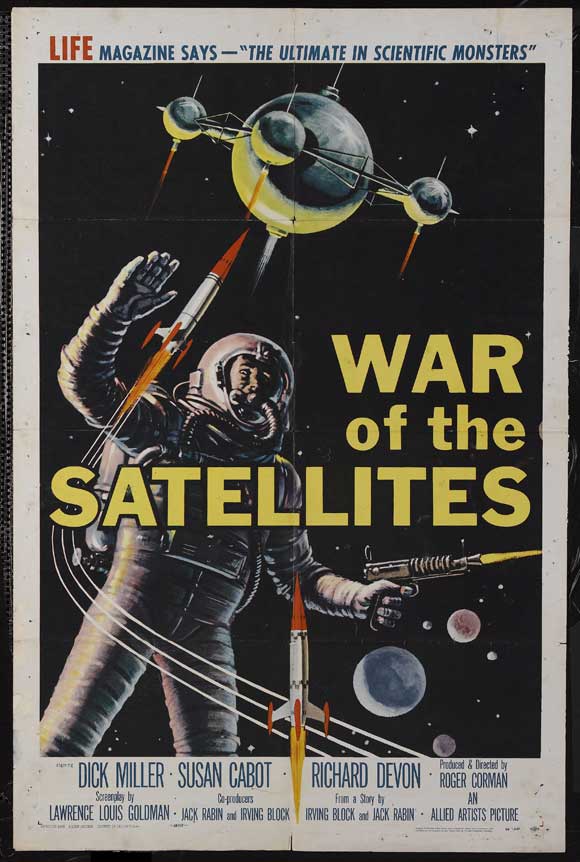 A Faux News poster. No one wears a spacesuit brandishing an NRA in the movie.
A Faux News poster. No one wears a spacesuit brandishing an NRA in the movie.
Here’s the set-up, a united Earth through the United Nations is launching satellites. While some delegates in the sparsely attended UN sessions are skeptical that the satellites will work, they are nonetheless party to the effort. The Cold War is only obliquely present when one character refers to ‘them’ who would like to see ‘us’ fail. It makes no sense in the context of UN but echoes the Cold War context.
Hey, the skeptics have a point. As the pix opens nine satellites — one after another — have already been launched and each has blown up as it reached the Mendoza line.
Note on terminology. Corman always does things his own way and he calls the space vehicles satellites, and he should know, but they look like small space stations, each with a crew of ten, and move through the void like chubby spaceships with porcupine antenna. Maybe the production was named and the design of the craft came later. In a Corman production there would be no money to re-do anything already done, like publicity material. And this was a rush job to get on the con trail of Sputnik and maybe that is the explanation. Sputnik was a satellite so this has to be a satellite no matter what it looked like or did.
Nine exploding satellites means ninety dead volunteers. The head of the mission is Pol van Ponder not even attending the requiems for his dead. (The fraternity brothers amused themselves with that name, especially later when he hit on the required woman in the crew.) Ponder ponders the situation and decides to press on, but wait…..
Meanwhile some teenagers doing an extra-credit anatomy lesson in a secluded parked car are disturbed by a bright light from the night sky. Wow! That brings things to a head. Then there is a flash and crash. Wacko! They find a small rocket that has just burned through the atmosphere but they pick it up and have a look. On it is an inscription in Latin. Latin! Latin?
Is this a premature July 4th Roman Candle? Is it a message from the Pope to these two teenagers to button up and go home!
After consulting Mr. Pomfritt off screen, the teens turn the rocket over to someone who passes it on to the UN scientists at the satellite project. An ancient Roman translates the message.
‘This is a warning! Do not attempt any more space flights. Your corrupt world will NOT be permitted to infest the Universe!’
Gulp! Corrupt? Did they foresee in 1958 the Twit in Chief of 2017?
Ah, but there is a twist here. Pol van Ponder rushes to the UN meeting where a response to the Latin message is being slowly composed in the ablative case. But, then there is that bright light in the night sky again. It goes all disco as a strobe light and blinds, let’s call him Van, Van who crashes his car which by Hollywood convention bursts into flames. No more Van. (Picky viewers note that we never quite know where we are, there are California plates on Van’s car, but the UN is in New York City, and the missile launches of the time were from Florida.)
Without Van there is no satellite program. End of story. Whoops, almost, but then at the Council Room, half empty as usual, Van appears, in tact. Not a tear in his tweeds. Amazing! Relief is general.
Spoiler alert. Stop here to save the best for a viewing.
The Latin-writing aliens have somehow both burned Van’s body to the ashes found in the incinerated car and fabricated an exact replica Van who now acts as Van with his memories and the same dour personality. There’s more.
As we quickly learn this New Van has a split personality.
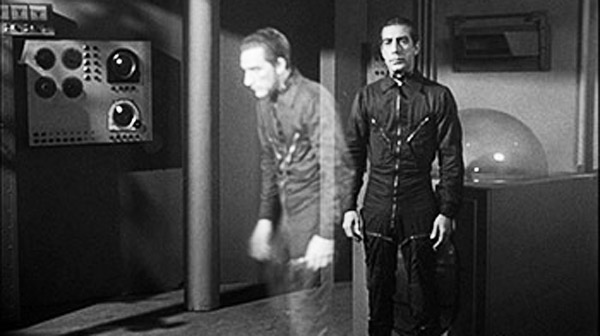 Van splits!
Van splits!
He can be two places at once! Imagine the advantages of that for KPIs. The scene where he splits into New Vans 1 and 2 is neat. It seems it is not something he can or need do a lot but he can do it when necessary.
The New Van is dedicated to scuppering the satellite program from within. What with Latin homework, the UN is about to give up anyway. Who wants to decline Latin conjugations. New Van sits back and waits for the inevitable defeat, but his pint-sized underling Dick goes to the meeting and makes a speech worthy of the Twit in Chief. Full of words. Good. Ones.
‘The very reason we have to go into space is to prove we can!’
With that great logic and his duck-tail haircut he wins over the delegates, who, as they think of their actors’ guild minimum paycheques, applaud his words. Listening on the radio, New Van is cranky about this turn of events and furrows his frontal lobes. Never good when an alien does that.
A tenth satellite is prepared and New Van volunteers to captain the crew, risking his own life. Remember the ninety space corpses already compiled. His plan is to botch the mission. He could do that by convening a 360 degree review or a SWOT analysis, but instead of McKinsey-Speak he prefers a more direct approach, a wrench in the reactor.
Now the title satellites are complicated affairs, as we now learn. Three rockets are launched, each with two stages. By the way, the ground control operator who shepherds them into the void is none other than Roger Corman. Once the three rockets rendezvous by the magic of wire and glue, they emit little dishes that join up to form the satellite, space station, ship. Too bad NASA did not go this route.
Picky viewers will note the same set is used both to the launch rockets and the satellite. Pedants will add that the previous nine satellites mean twenty-seven rockets have gone to the space junkyard orbiting the Earth. What was that about a polluting infestation anyway?
Now we have the satellite and New Van starts sabotaging it, but the crew keeps getting in the way. Moreover, tiny Dick spotted New Van, just before taking off, splitting in two. No one believes a haircut like that.
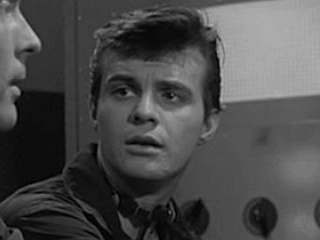
New Van continues putting sugar in the reactor. Another crewman also suspects New Van but he and Dick never do compare alien-spotting notes. Let’s call this other crewman Jerry, who confronts New Van.
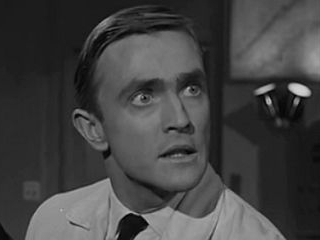 Jerry made his eyes pop off the screen, but it did not scare Van.
Jerry made his eyes pop off the screen, but it did not scare Van.
End of Jerry. He goes out the Memory Hole into space. More in the junkyard.
Then the doctor, prodded by Dick, examines New Van. Oh oh.
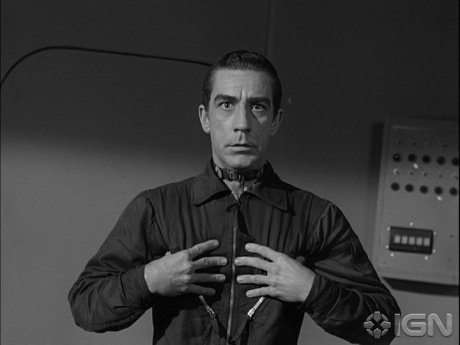
New Van quickly gives himself a heart beat for the examination. That satisfies the doctor briefly but later he, too, confronts New Van and with a flick of the wrist, he, too, goes down the Memory Hole to the void. What is the body count now? Ninety-two.
New Van blames the deaths on Dick, who then runs up and down the same empty corridor for ten minutes. Exercising while in spaces essential.
Meanwhile, New Van with a heart now hits on Wasp Woman, much to her surprise for she has only had eyes, many of them are needed, for little Dick. (She played Wasp Woman in another Corman extravaganza though in fact the insects were bees, but no one told her before her business card was printed.) Now with a heart New Van has become a weak-willed and lustful human. He divides himself again, and — for a brief moment, as the fraternity brothers tensed — it looked like New Van 1 was going to clobber New Van 2 for being such a cream puff.
But no, he splits so one of him can molest Wasp Woman, while the others stuffs Dick down the Memory Hole. Ah, but Dick brought along his cap gun and threaten New Van 2 (NV2 hereinafter) who laughs. ‘Your weapon cannot hurt me!’ (He had not read the script, it seems.) Now that NV2 has a heart, he is vulnerable. Bang! Bang! NV2 crumples at Dick’s size-five shoes, and in another empty room NV1 clutching for Wasp Woman also crumples. Whew! Code violation averted.
Quickly Dickie takes command, inserting new solar batteries in the satellite which then bursts through the Mendoza Line where the other nine satellites were destroyed. The satellite sails into space to infest it with the corruption of the Earth. The end.
Evidently the aliens on Line duty, perhaps thanks to budget cuts, did not have any more tricks to use. Or maybe they were in a meeting about KPIs.
Where the satellite is going no one bothers to mention. It just boldly goes….
Why these English-speaking aliens chose to inscribe that warning Roman Candle rocket in Latin has bothered the fraternity brothers since 1958. There is no explanation in the film, and in 1958 it was no more a global language than Swahili.
Much in evidence in the parking lots are 1958 Detroit gas guzzlers with tail fins and chrome. They go with the duck tail. We also like the recliner chairs for space flight and the black zip suits.
The cast includes actors who were stalwarts in Batman (Michael Fox was Inspector Basch) and Superman (Robert Shayne was Inspector Henderson). Both parenthetical inspectors were veterans of B movie Sy Fy. But Richard Devon as Van carries the picture with his dour monotone, until he gets a heart and there flickers emotion in his eyes and a twitch of the lips. About Wasp Woman and Dickie the less said the better.
 Roger Corman at the ground controls.
Roger Corman at the ground controls.
After seeing movies by Al Zimbalist, Ed Wood, and Lee Wilder, Corman seems like a genius.
‘Killers from Space’ (1954)
Peter Graves made this for a Wilder in 1954, the year before he had made ‘Stalag 17′ for a Wilder. What a different a Wilder makes. More on this enigma at the end.
First the IMDb facts, it runs for 1 hour and 11 minutes of Dali time, and the 1566 ratings average to 3.1/10. That is right at the Mendoza line.
Grave Peter is abducted by aliens, a frequent occurrence for those from Minnesota, but instead of the anal probe that St Paul of ‘Paul’ (2011) made (in)famoius, they bring him back from the dead with a heart transplant. He never says ‘Thank you.’
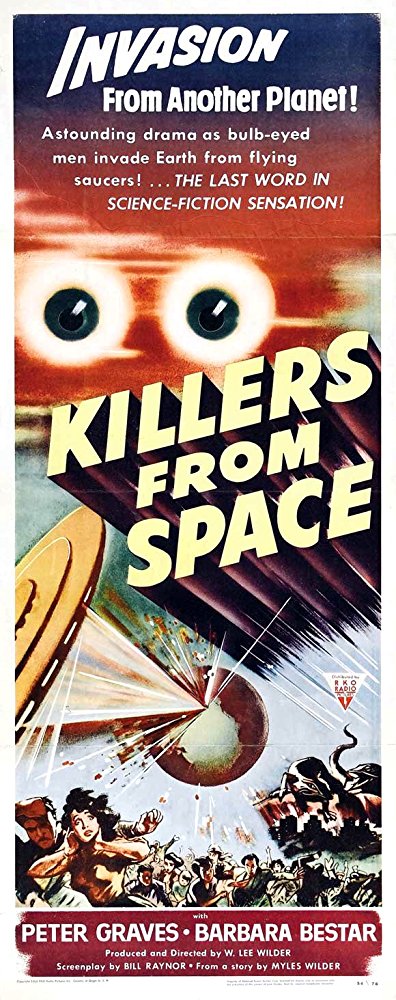 A lobby poster straight out of Faux News
A lobby poster straight out of Faux News
What happened? Grave Peter is a nuclear scientist who knows as much as Kevin about nukes, and is participating in above ground nuclear testing in Nevada (which then as now is not much good for anything else). Since the tests are atomic bomb drops and the technicians, politicians, generals, grunts, journalists, and scientists stand around with sun glasses on to watch, there is also plenty of longer term killing right there. In addition, everyone smokes.
The plane Grave Peter is in mysteriously crashes and is incinerated. The assumption is that he was barbecued in the pile of ash. Grieving Wife sheds a tear. Wooden colonel stiffens his upper lip. The next test is scheduled. Must not hold up progress to Armageddon.
Then Grave Peter in a ragged jumpsuit walks home in a daze. Whacko! He survived! But how? He is stunned and remembers nothing. Not even the massive butchers’ scars on his chest. The fraternity brothers were sure they would remember something like that no matter how OBs they drank.
He is physically fit after a shower, shave, coffee, and a pipe (being a tweedy scientist he smokes a pipe so he can leave a trail of ash for the plot). Yet he remembers nothing. Mondayitis? While the examining doctor remarks on the scars, he does not investigate them in any way. Guess it was a short 15-minute consultation on the Medicare scale and there was no time for more.
The shadow of the Cold War falls with a thump. What if this Grave Peter is a substitute planted by you-know-whom. The real Grave Peter could not have survived the crash. Ergo this one is an imposter. What other explanation could there be, Erich? This possibility does not explain the scars but no one seems to care about that. He is sequestered in the base hospital under observation, i.e., hospital arrest to await the Good Doctor to come and fix him up. But he is compulsive about carrying on. This arouses more suspicions by the wooden FBI man on the scene.
With the touching faith in drugs of B-movies, they shoot up Grave Peter with a truth serum, and he tells all. This is one blabber mouth. It goes like this:
He awoke on an operating table just as a heart, he says his, but he would wouldn’t he, was stuck back in his chest by a mechanical arm attended by the losers of a Ping Pong match.
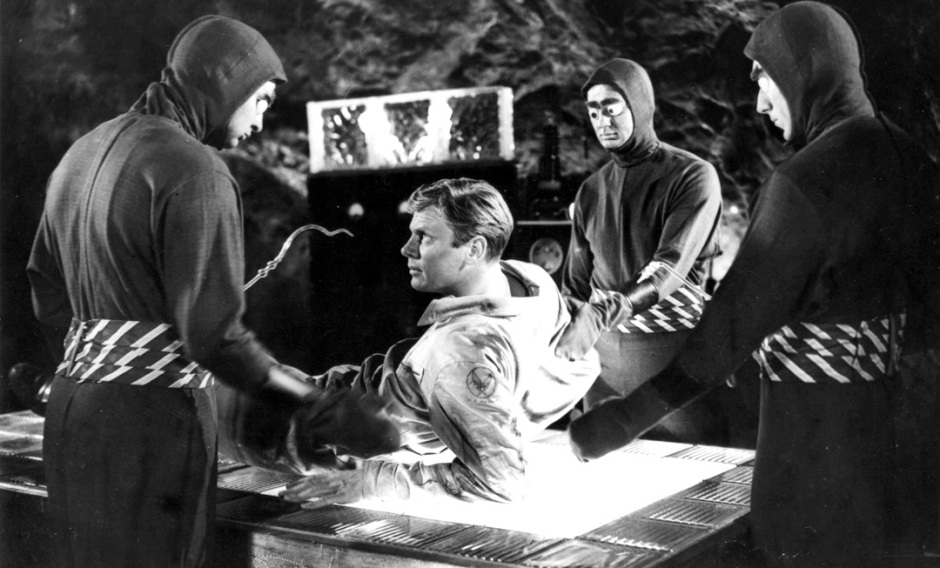 Grave Peter in post-op.
Grave Peter in post-op.
He raves about those eyes. ‘Those eyes!’ He does this a lot.
Then the drug wears off and he wakes up in the hospital to find the doctor, the colonel, the stooge, and the FBI staring at him liked he just confessed to liking the Osmond Family’s music! Disbelief isn’t the half of it.
Conclusion: He’s no commie plant; he’s crazy. They change the locks on the hospital door. Well, no they don’t. And he is now determined to clear his name alone! Not only is he not a commie, he is not crazy, though why else did he accept this part? Grieving Wife is nowhere to be found. Another abduction? We’ll never know.
He breaks into the top security military base, he breaks into the top security safe, where he leaves pipe tobacco ash (was this an unconscious plea to be stopped?) and steals the nuclear test data.
He drives into the night, since the budget did not run to lighting, and sticks the top secret results under a rock. Oops! This is the very rock the FBI man is standing on in Bronson Canyon. Of all the rotten luck! There is punch up and Grave Peter flees. For a tweedy scientist he can hit below the belt with the best of them.
While I was raiding the refrigerator, he got himself into the aliens’ den where the Bug Eye in Chief talks to him. ‘We speak all languages,’ replies bug-eye numero uno Grave Peter’s amazement that he speak English. Polyglot, uh, a sure sign of someone up to no good. BEiC then explains to him in detail the nefarious plot in the best Dr No fashion.
They have destroyed their own world thanks to the climate change deniers and now have to relo. Earth will do, but first they have to rid it of us humans. To do this, sparing Occam’s razor, they will use the radiation from nuclear tests to charge the batteries in the hot house where they are breeding giant spiders and ants (some of which escaped to ‘Them’ [1954] – much the better film) and once they have enough creatures for a feature, they will unleash them to devour humanity. Gulp! One suspects a sequel in the works.
Now the Earth will be overrun with big bugs, but not to worry, then the bug eyes will spray DefCon to kill the insects, whose rotting bodies will fertilise the soil. See, a grade A plan with KPIs galore. In this case of McKinsey speak KPI means Killing People Immediately. Grave Peter is impressed with the grantsmanship of the plan, but instead of throwing in with them as a nuclear expert and getting promoted to Honorary Bug Eye, he escapes.
No gratitude has he. While babbling Geordie-speak he rushes to the one power planet in the place and brandishing a pistol that came with the elbow patches on his tweed coat, he throws all the switches to Off, including the MASTER Switch. Darkness fell. Iron lungs stopped, ‘I Love Lucy’ went blank. Surgeons said ‘Oh Oh.’ Nine months later there were surprises. But the power is off only a ten seconds, so maybe not so much of the latter.
The wooden ones, the colonel, the FBI, the stooge, Grieving Wife are now looking for a net to throw over Grave Peter when KABOOM! That was the sound of the aliens’ den blowing up, just as Grave Peter predicated! The mere sound of the explosion clears everything up and he is welcomed back on the road to Armageddon.
The end.
Seen today there is a message about destroying one’s own world by electing idiots, and another about the dangers of radiation. But neither of these was intended at the time. Just plot devices though a few films like ‘Rocketship X- M’ (1950), reviewed elsewhere on the blog, do have an ever so carefully put case about the dangerous of nuclear radiation. Enough to get the screen writer a mug shot it was. But that was exceptional. In 1954 any doubts about the safety of nuclear energy and weapons were Commie tweets.
The only thing a sensible viewer remembers from this celluloid is the bug-eyed aliens. There are conflicting stories about this effect was achieved. The budget did not run to having anything made by a optician. They look like Ping Pong balls and that is the usual explanation, cut in half, with a black dot painted on them in which is a pin hole so the actors with them glued to his eye sockets does not stumble over a paycheque.
Though there is another story according to which Wilder himself came up this idea. He opened the refrigerator at home to get a beer and noticed the white egg rack built into the refrigerator door. Hmmm.
He yanked the rack out, cut the egg cup receptacles off, and ‘Voilà!’ alien bug eyes without the expense of Ping Pong balls. Because this is a difference without any significance, it heats up cyber space as adherents to the Ping Pong ball explanation dispute with Egg Rack believers. The tweets fly. Good thing they don’t have nukes.
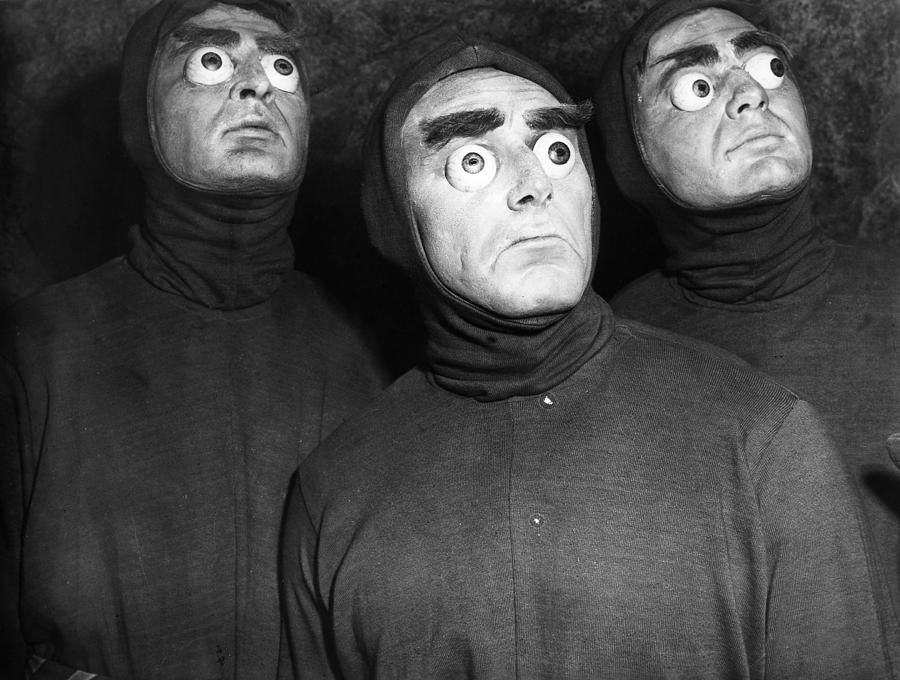 Ping Pong balls or egg cups? You must decide.
Ping Pong balls or egg cups? You must decide.
Peter Graves went on and on. His last credit was in 2010, the year of his death. This man seldom said no. Witness ‘Airplane!’ (1980). In the latter part of his career he often played, parodied, himself, grave, stalwart, gravelly voiced, and wooden. In 1954 he was impossibly handsome and trying very hard. But maybe he should have said no now and then.
Lee Wilder produced and directed ‘Killers from Space; hot on the heels of the ‘Snow Creature’ (1954). Since a Lee Wilder movie took no more than a week to film, he could turn them out when there was coin. Coin? The story goes that Lee left his native Austria and migrated to New York City where he became a very successful hat maker. Whether for men or women is a question only further research could answer. His younger brother Billy was cinema-struck as a boy and had gone to Berlin to learn the business.
Reading the blood signs on the street in Berlin, Billy wanted to go the Amerika, and brother Lee paid his way. Billy said thank you and took train to Lost Angeles where talking movies were the go, and he saw his future in that. Off he went, and the string of commercial and artistic successes is now legend. He made one of his masterpieces, ‘Sunset Boulevard’ in 1950. By then he was so well established he could defy Tinsel Town conventions, command extraordinary budgets, attract great stars out of retirement, make a star out of an also ran..…
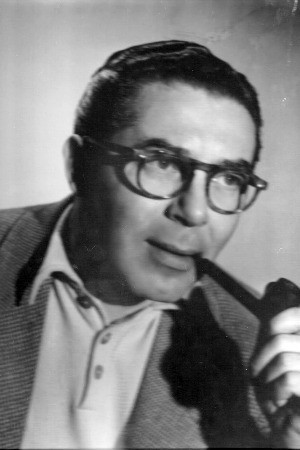 Lee Wilder
Lee Wilder
Is this a case of inverted sibling rivalry? Older brother Lee then sold his New York City business and moved to Lost Angeles and set himself up as an independent film producer with his son Myles, who did not have to be paid, as the screen writer.
My five minutes of web research indicates that there was no rupture between the brothers, but though they both made films and lived in Lost Angeles they never met there and when they bumped into one another, they exchanged nods, not words, and went on.
‘Snow Creature’ (1954)
IMDb 3.1/10 from 711 votes at 1 hour and 9 minutes of Dali time.
This title is often found on those list of films that are so bad that they are fun to watch. Just about everything is wrong. Error spotting keeps the viewers interest. Nothing else does.
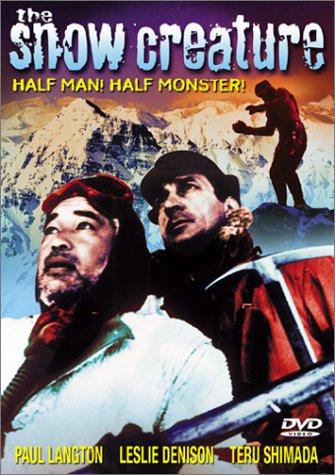
An American scientific team scales the Himalayas to find rare botanical specimens. This team has only two members, the botanist and a newspaper reporter to publicise the investigation for the ‘Daily Plant.’ To ascend the mountains they hire locals to schlepp the gear, including a radio (so they can follow the World Series?). They encounter the abominable snow man! Yeti they do! They subdue him and ship him back to Lost Angeles where half the film is set in the dark. He escapes and wreaks so little havoc few in LA would notice. The forces of order are mobilised and slay the beast. End of story.
At least half the footage is stock film of airplanes landing and taking off. Nearly all the shots of the actors are in the middle distance. No close ups. A sure sign of a tip-jar budget. Shots of the trekkers are repeated again and again. The one close up of Abominable is repeated three times. The first time it was effective when he stepped back into the darkness. Less so on each repeat. When he is photographed on a slope in the distance, he looks so awkward and fragile that a gust of wind would level him. Some threat.
Another sign of a micro budget is that much of the story is told through voiceovers and not dialogue. That indicates no sound man on the payroll. Nor is anyone credited with make-up in the credits, so Abominable had to do his own. He is clearly wearing a two-piece fur suit. He is seen only once in a close up, and he looks wrapped up like the invisible man.
The fraternity brothers liked the footage of aircraft. In the first, the voiceover ponderously says they are flying into Bombay. Time to change airlines, folks! On the ground beneath the aircraft clearly visible are the pyramids of Giza. That pilot missed India! Cairo, Bombay, what’s the difference?
But wait, there is more. Later after boxing up Abominable (on that more in a moment) the voiceover has them landing in Lost Angeles. Hmm, yet beneath the aircraft we see the Statue of Liberty from New York City Harbor. No continuity editor is in the credits either, though this blunder is beyond the pay grade of a continuity editor.
Those instances indicate the quality of this celluloid from the Dream Factory.
The natives who figure in the first half as bearers are Sherpas, only one of whom is endowed with a name. The others go by ‘Hey you!’
But wait, there is more. They all speak Japanese. Yep, all the Sherpas are Japanese. The fraternity brothers thought the Japanese had been driven out of India by 1944 but apparently some remained under cover as Sherpas. The more prosaic explanation is that the only extras who looked Asian the producer could get at the price were Japanese, and to let them use Japanese was good enough for the Sherpa tongue.
There are condescending and racists asides by our heroes about the Sherpas on whom their lives depend.
The duo stumbled upon Abominable in his lair and the roof fell in and stunned him. Thus incapacitated they tied up this Gulliver and shipped back to the States for study in a refrigerated telephone booth. This was no Tardis.
They knew Abominable was about because it was alleged he had creature-napped a Sherpa woman, but that loose end it left flapping. Just one less Sherpa to make stupid remarks about.
Abominable descends into LAX, and like many travellers is consternated. Officials with clipboards appear, asking what is in the phone booth. Having seen, Dr Who in action, they are careful. If it be man, where is his visa and passport? If it is beast, where is the quarantine certificate? The officials cannot decide. Can we? This is the only interesting scene in the film, and much, much more could have been made of it. Is Abominable a man or a beast? What about the Twit in Chief?
The journalist has made a sensation of him as a man, whereas the good doctor refers to him as an animal. The officials are inclined to believe what they read in the ‘USA Today.’
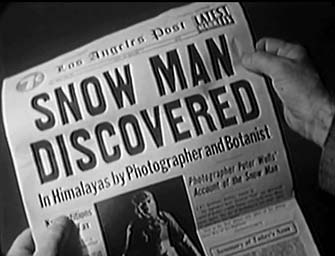 The Murdoch press, as responsible as always.
The Murdoch press, as responsible as always.
Yep. Hard to believe, but if a journalist says Abominable is a man, maybe he is.
To resolve this conundrum, the officials send for an expert. Huh? An expert in what? A theologian perhaps? A talk-back radio shock jock? A fraternity brother, often accused of crossing the line between human and beast? Who?
Whatever this Doctor’s qualifications he arrives, and sits at a desk. No, he does not look at the subject but smokes cigarettes at the desk. That’s how we know he is a regular guy.
By this time, Abominable has had enough waiting in his cubicle and he tips it over and this breaks it open and off he goes to wreak havoc here and there. Women are his prey, though why and what his motivation is, no one bothers with. Maybe he wanted return fare?
At no time was any effort made to communicate with Abominable but maybe he only understood Nepalese and neither Japanese nor Hollywoodese. To keep him quiet before the phone booth was ready they just keep cracking him on the noggin.
In Lost Angeles the rampaging Abominable Man is declared NRA-bait and Bam! They get him. Too bad, but it had to be is the coda.
The one cliché absent from this hash is the comic relief. For that relief much thanks.
No one is credited for the part of the Abominable Man but the gossip is that it was Lock Martin, whose role as Gort was unforgettable and this one was unfortunate.
Late in the piece the ever reliable William Phipps enters and tries to eject some life and humanity into this script but even he fails.
This film is one of several B- creature features made by W. Lee Wilder, the older brother of Billy Wilder, who got all the cinematic genius in the family. Lee Wilder used a screen play written by his son Myles Wilder. Case closed. They say Lee Wilder made worse films, hard though that is to believe.
‘Prisoners of the Lost Universe’ (1983)
From the IMDB 3.7/10 from 878 votes, running 1 hour and 30 minutes Dali time. For a Sy Fyan this is a zero (0).
It comes up in searches for Sy Fy but it does not make the grade, but since I had to sit through it to discover this fact, I will give it a few words.
 As crassly misleading as adertising must be, it seems.
As crassly misleading as adertising must be, it seems.
In 1983 contemporary Lost Angeles a blood sucker (journalist), a working stiff, and an uncle of Erich’s get transported to an ‘alternative universe.’ One at a time. Like the Three Stooges, each one makes the same mistake and gets transported through the photocopier. Pretty sure they did not go to Wonderland.
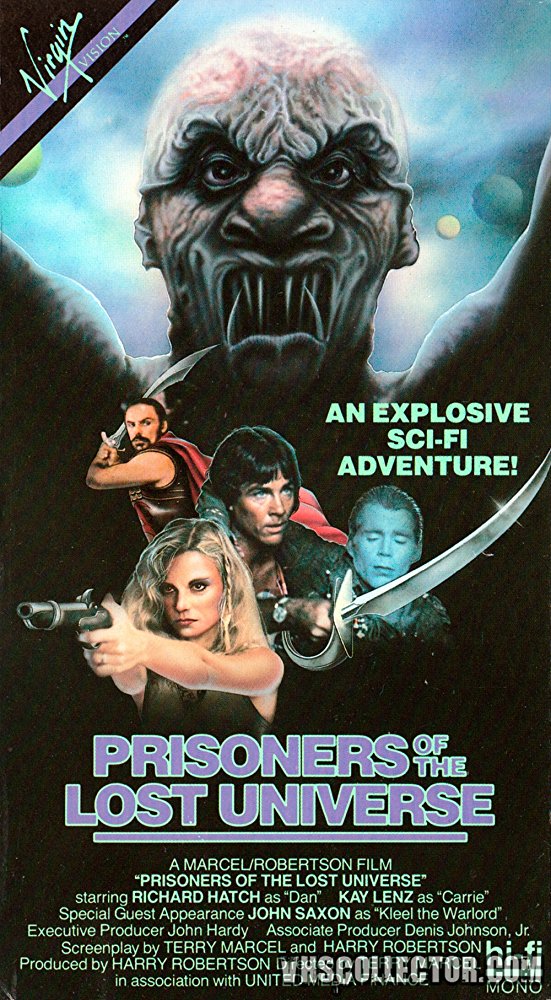 This poster pretty sums up the picture.
This poster pretty sums up the picture.
Once there Uncle is nowhere to be found, while Blood Sucker and Working Stiff stick together, ahem. Yet even afterward they still seem tense. The Fraternity Brothers found that odd, but then there were no cigarettes available.
After some roaming around they conclude that this is Disneyland with creeping thingies, hairy cave men, green elves, and more. This is a stone age world with spears, animal skins and furs for clothing. Altogether so primitive that the fraternity brothers felt right at home amid the grunts, thumbs, and beasties. They get into and out of scrapes and the time passed, slowly. S l o w l y,
The credits promised Carmine Orrico and so I persisted because if there anyone who can inject life into …, well, into a film it is Carmine. By the way the Hollywood gossip vine is full of strange stories about his life style choices. Even in Tinsel Town it is outré. He must have saved all his vices up for that because in this part as the Villain in Chief he looks bored, distracted, and worried (about his next doctor’s appointment). In equally limp offerings he has put some steel into the flaccid films. Not so here.
Uncle is working for Carmine as a wizard and Carmine makes sure his wizard does not find a way back to his own alternative universe.
Working Stiff is Richard Hatch from both versions of Battle Star Galatica with Sy Fy credentials, which also enticed me into viewing this swords and sandals bore.
Kay Lenz is Bloodsucker and she reminded me of Gretchen Corbett from ‘The Rockford Files,’ an old favourite. Doppelgänger one for the other they are, as a check for net pixes confirmed.
Most of it is out doors and though it starts with Lost Angeles, the whole thing was filmed in the Republic of South Africa of apartheid. When Bloodsucker is driving to meet Uncle at the outset the car radio is from LA and she drives not on the right, though the car is left-hand drive. The first hint that it was not filmed in the Alabama Hills, though that is the look, in a very dry summer. While the credits show many actors from the Republic I heard nothing I think of as a South African acccent. Still less did I see any black faces. Apartheid on the set, did not present a problem to the cast and crew, it seems.
The director also wrote the screenplay, served the tea, and must have many relatives to account for the few positive remarks in the User Reviews on the IMDb.
While Uncle refers to it as an alternative universe, in the marketing department this became ‘the Lost Universe.’ Of course, it is not lost to those who live there.
